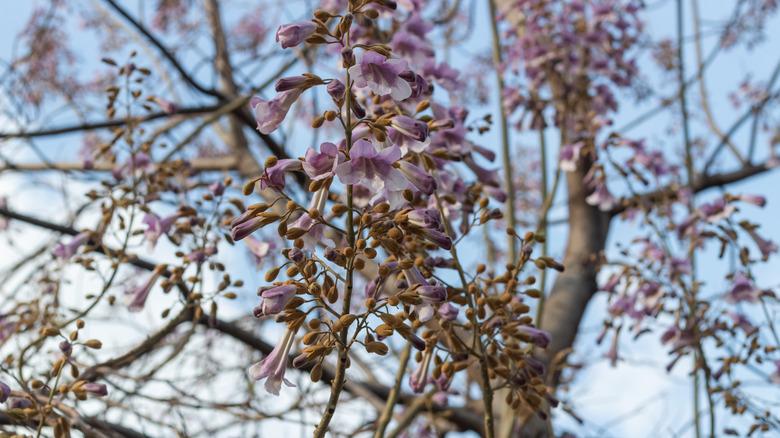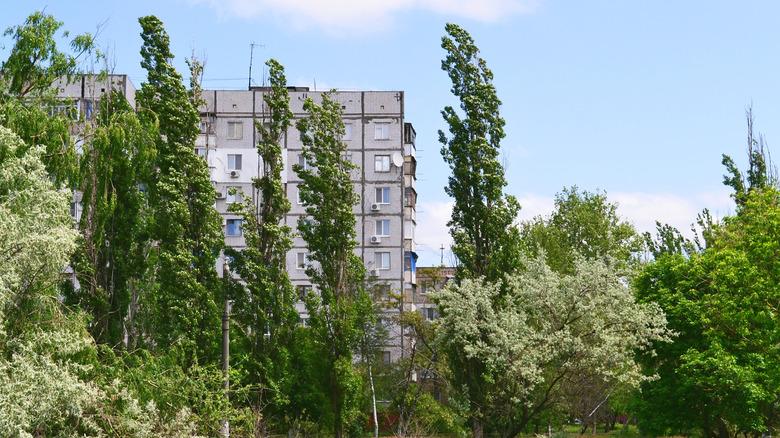Growing These 11 Plants Too Close To Your Home Could Be A Big Mistake
While landscaping and gardens can be considered the ultimate finishing touch for a house to boosts curb appeal (some even say landscaping can sell a home), not all plants and trees are a good idea to put in your yard. Some trees and plants out there can cause damage to homes, while others are a pain to maintain and clean up after during certain seasons. There are also some plants that can be poisonous to people and pets, making it riskier to place them in the areas that your family frequents, close to the house.
Sometimes it's not very obvious from the outset that these plants can do more harm than good, particularly if the plant is beautiful to look at. Oak trees, for instance, are stunning, monumental trees with incredibly romantic appeal. However, their mature roots are dense enough to lift sidewalks (or even some housing foundations if planted too close to buildings). Some climbing plants, like English ivy, have also become so ubiquitous that we take for granted that they don't benefit the structure at they call home. If a particular plant or tree catches your eye, be sure to research how the plant grows and what the expectations are for care, especially if you're looking to avoid potential long-term damage to your house or gardens. These plants, therefore, are some of the worst choices to plant near your home for a number of reasons.
Foxglove trees can disrupt plumbing
It's no surprise that foxglove trees (Paulownia tomentosa) are often referred to as princess or empress trees by fans of the plant — its petite, trumpet-shaped, purple blossoms look like something plucked right out of a storybook, and would likely look really lovely in a front yard. Sadly, though, it is an incredibly invasive species that outcompetes native plants for resources. Its robust roots can also damage to paving and even plumbing, making it a terrible candidate for landscaping near your house as it can damage your front walkway. It's not very princess-like, at all.
Pine tree, the aromatic giant
While pine trees (Pinus) are evergreen beauties, their incredibly invasive roots make them undesirable around homes. Like many of their evergreen counterparts, pines' roots grow extensively outwards, seeking moisture when in dry soil. So in a time of low watering, the roots might be attracted to places near your home, like where downspouts empty. Thus, these trees should be planted at least 15 feet away from any structures. As an added warning, sticky pine needles are likely to get to become a nuisance as well, cluttering your roof, patios, and most annoyingly, sticking to your car's windshield.
Oak trees can cause significant damage
The common oak tree (Quercus robur) is a majestic tree, and while it's beautiful in large fields or in an arboretum, be forewarned that oaks can cause some serious damage to your home if planted too closely. Oaks are mighty giants that should be planted at least 20 feet from buildings, both to leave room for its roots to grow and to give dropping branches clearance from your house. Otherwise, in a few years time, you may find a robust, subterranean root lifting pieces of your yard, or if there's a good breeze, you could find a branch punching a hole in your ceiling.
English ivy can take over
English ivy (Hedera helix) is a rapidly growing, invasive woody plant that escapes cultivation easily, spreading quickly on the ground and up building walls. While it looks very fairytale-like on the sides of homes, sadly, it can cause long-term damage. Its aerial roots can grow into vulnerabilities on the wall, exacerbating cracks, and it can even grow into gutters and eaves. Thick layers of ivy can also create humidity issues for your home as well, since your walls won't be able to breathe properly. Removal is incredibly difficult since it's both time-consuming and costly.
Japanese knotweed, the invader
Japanese knotweed (Fallopia japonic) is an extremely prolific plant that grows similarly to bamboo, and much like its woody cousin, Japanese knotweed is incredibly invasive in the U.S. It drains resources away from native plants and easily takes over yards. If planted too near buildings, it's known to grow through cracks in concrete, shooting up through pavement, or even through concrete foundations. Knotweed is so prolific, that some measures of removal, like mowing, actually helps facilitate its spread; trying to get rid of it this way actually stimulates further growth. Thus, avoid introducing new knotweed altogether.
Black poplar trees' weaknesses cause damage
Black poplar, also called lombardy poplar (Populus nigra), are highly susceptible to diseases and unwanted pests, and as a result, these trees' structures can be significantly weakened. If planted too close to your house, the weakened trees are prime candidates to be felled by a storm or strong winds, making your home (and, notably, your roof) vulnerable to damage. This tree also sheds frequently, so it may pile debris onto your front porch and into your gutters.
Willows are thirsty giants
Willows (Salix) are another mighty tree that's beautiful to look at it, but has an expansive and destructive root network. These roots crave water in a big way, so they will travel towards water sources and grow larger in that vicinity. This includes pools, pipes, and landscaped ponds alike, meaning the roots will travel towards those things and disrupt or damage the surrounding structures as a result. Willows, therefore, should be planted at least 50 feet away from those elements. There are also structural growth problems with willow varieties too, including brittle branches that can drop on houses and cause clutter.
Sweetgum trees can damage foundations
While American sweetgums (Liquidambar styraciflua) are beautiful, deciduous trees with fiery red leaves in the fall, they can be incredibly damaging to foundations, patios, and pavers. Their aggressive root system grows large and grows fast, and won't be stopped even if you cut the root back. That said, it is incredibly difficult to stop the roots of a sweetgum from lifting parts of your house and yard. The spiky fruit of the sweetgum can be painful if you step on one, and they drop from trees in multitudes. Sweetgums are also susceptible to branch loss in strong winds, another reason to keep them clear of your roofs and windows.
Horsetail is the hardy weed that grows through asphalt
While this fern-like weed is native to North America, horsetail (Equisetum arvense) is not the addition to the yard you'd want near your home. It's an ancient weed that's incredibly difficult to eradicate, with creeping rhizomes that can grow as deep as seven feet below the surface. Once bent on spreading, it can grow rapidly and is even pernicious and strong enough to grow through asphalt. If cultivated and kept trimmed in a pot, horsetail plants can lend a decorative air to porches, but if grown in your landscape, it can make the porch its playground.
Eucalyptus trees are a fire hazard
Eucalyptus trees (Eucalyptus) are much like their willow counterparts — they're incredibly thirsty trees with a root spread of up to 100 feet. They seek water sources and are known to grow into septic tank systems, a catastrophe for homes. And while the scent of their leaves are lovely, the oils found within the tree that gives off said aroma are incredibly flammable. The trees also produce flammable gases, which during nearby fires can cause fireballs and explosions that dangerously help flames spread. Therefore, keep these giants well clear of structures.
Hogweed is a dangerous dupe
Hogweed (Heracleum mantegazzianum) has been used as an ornamental dupe for Queen Anne's Lace, and also resembles clustered flowering plants that are beneficial to gardens like yarrow, however, the truth behind this dupe is dangerous. Considered invasive in certain areas of the U.S., this flowering plant can grow to incredible heights quickly, making it difficult to control. Removal is extremely problematic, as hogweeds' sap is phytotoxic and can burn human skin. Burning the plant will release noxious gases, and it can also continue growing in trash if not properly dried out first. Having this weed close to your home can be a health hazard for all occupants. Generally, avoid this plant.











